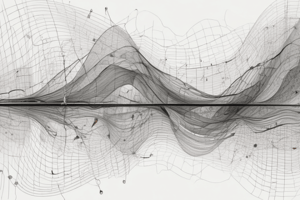Podcast
Questions and Answers
In a research paper, which section provides the justification for undertaking a study by detailing the problems/issues, importance, gaps, and urgency?
In a research paper, which section provides the justification for undertaking a study by detailing the problems/issues, importance, gaps, and urgency?
- Rationale/Background of the Study (correct)
- Research Objective/Statement of the Problem
- Conceptual Framework
- Review of Related Literature
Which section of a research paper outlines the variables and defines the relevant objectives to map the research outcomes?
Which section of a research paper outlines the variables and defines the relevant objectives to map the research outcomes?
- Conceptual Framework (correct)
- Research Objective
- Hypothesis
- Review of Related Literature
A researcher is investigating the connection between hours spent on social media and student performance. If the null hypothesis states, 'There is no significant relationship between social media use and academic achievement,' what type of hypothesis is being used?
A researcher is investigating the connection between hours spent on social media and student performance. If the null hypothesis states, 'There is no significant relationship between social media use and academic achievement,' what type of hypothesis is being used?
- Educative
- Alternative
- Null (correct)
- Theoretical
Consider a conceptual framework that links 'Inquiry-Based Science Education' to 'Metacognitive Awareness of Senior High Students.' Which research question best fits this framework?
Consider a conceptual framework that links 'Inquiry-Based Science Education' to 'Metacognitive Awareness of Senior High Students.' Which research question best fits this framework?
Which part of a research paper clarifies how the variables are measured and utilized in the study?
Which part of a research paper clarifies how the variables are measured and utilized in the study?
A researcher aims to determine the impact of their study on a specific field. Which section of the research paper would address this?
A researcher aims to determine the impact of their study on a specific field. Which section of the research paper would address this?
In a research study, what is the purpose of the 'Scope and Limitations' section?
In a research study, what is the purpose of the 'Scope and Limitations' section?
Which of the following sampling techniques is NOT considered a probability sampling method?
Which of the following sampling techniques is NOT considered a probability sampling method?
A researcher wants to investigate the lived experiences of single mothers during the pandemic. Which research design is most appropriate?
A researcher wants to investigate the lived experiences of single mothers during the pandemic. Which research design is most appropriate?
In a study examining the relationship between social media advertisement and consumer buying behavior, a statistical analysis yields a correlation coefficient of $r = 0.915$ with a $p$-value of $0.002$. What conclusion can be drawn?
In a study examining the relationship between social media advertisement and consumer buying behavior, a statistical analysis yields a correlation coefficient of $r = 0.915$ with a $p$-value of $0.002$. What conclusion can be drawn?
Flashcards
Rationale/Background
Rationale/Background
Justification for a study, including problems/issues, importance, gap, and/or urgency.
Research Objective
Research Objective
States what the research intends to achieve.
Conceptual Framework
Conceptual Framework
Illustrates variables and defines objectives, mapping research outcomes.
Null Hypothesis
Null Hypothesis
Signup and view all the flashcards
Alternative Hypothesis
Alternative Hypothesis
Signup and view all the flashcards
Definition of Terms
Definition of Terms
Signup and view all the flashcards
Significance of the Study
Significance of the Study
Signup and view all the flashcards
Review of Literature
Review of Literature
Signup and view all the flashcards
Scope and Limitations
Scope and Limitations
Signup and view all the flashcards
Convenience Sampling
Convenience Sampling
Signup and view all the flashcards
Study Notes
- These notes cover key concepts in practical research, particularly quantitative research methods
Research Paper Components
- The Rationale/Background of the Study details the justification for conducting research, including problems/issues, importance, gaps, and urgency.
- The Research Objective describes what the research aims to achieve.
- The Conceptual Framework illustrates variables and defines research objectives to map outcomes.
Hypotheses
- A Null Hypothesis states that there is no significant relationship between variables (e.g., Facebooking hours and student performance).
- An Alternative Hypothesis states that there is a significant difference between variables (e.g., well-being of ABM students based on sex and grade level).
Research Questions and Objectives from a Conceptual Framework
- Descriptive research problems can be derived from elements of a conceptual framework.
- Descriptive research objective example: Measuring the level of metacognitive awareness among senior high school students
- Inferential research objective example: Determining the relationship between inquiry-based science education and metacognitive awareness.
Research Paper Elements
- Definition of Terms clarifies how variables are measured and used.
- Significance of the Study refers to the study's contributions and impact on a research field.
- Review of Related Literature involves systematic analysis of documents relevant to the research problem.
- Scope and Limitations defines the study's boundaries.
Sampling Techniques
- Probability sampling techniques include systematic and stratified random sampling.
- Purposive sampling is NOT a probability sampling technique.
Referencing Style
- APA 7th Edition is used to document various materials, including webpages, books, and journals.
Research Designs
- A quantitative, non-experimental, descriptive-correlational design determines the relationship between variables, such as parental involvement and academic success.
- A qualitative, phenomenological design uncovers experiences, such as those of a single mom in the new normal.
- A quantitative, non-experimental, descriptive-comparative design determines significant differences between groups, such as digital well-being levels of ABM and STEM students.
Statistical Tools
- A T-Test is used to test for significant differences.
- Pearson Product Moment Correlation is used to test for significant relationships.
- ANOVA compares three or more groups of means in a dataset.
True-Experimental Research
- A true-experimental research investigates the effectiveness of an intervention utilizing both random selection and assignment.
Survey Instruments
- Validity and reliability are significant aspects of selecting a survey instrument, ensuring consistency and accurate representation of the population.
Population and Sample
- A population is the entire group from which conclusions are drawn.
- A sample is the specific group from which data is collected via a survey questionnaire.
Research Criteria
- Inclusion criteria are characteristics that prospective respondents must possess.
- Exclusion criteria are part of the research paper
Sample Size Calculation
- Yamane's formula determines the sample size needed for a given population.
Sampling Techniques
- Total enumeration involves including all members of a population.
- Convenience sampling selects units based on availability or willingness to participate.
- Non-probability sampling shows respondents unequal chance of being selected.
Conceptual model questions answered
- Descriptive research objective example: Assessing the level of spending behavior
- Appropriate statistical tool example: Mean
Data Gathering Procedure Sequence
- The proper sequence includes:
- Seeking permission from school heads
- Seeking permission from respondents
- Administering the questionnaire
- Retrieving the questionnaire
- Scoring, encoding, and tallying responses
- Tabulating the results
Hypothesis Testing
- r=0.915 signifies high positive correlation and p=0.002 means the correlation is statically signficant
- Remarks that need to be noted: The null hypothesis is rejected, while the alternative hypothesis is supported
Magnitude of Relationships
- A perfect relationship means the relationship is absolute, and there is no room for deviation
- A strong correleation means the variables closely correlate and provide some insights
Studying That Suits You
Use AI to generate personalized quizzes and flashcards to suit your learning preferences.




